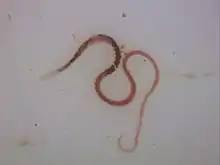Limnodrilus hoffmeisteri
Limnodrilus hoffmeisteri, also known as red worm, is one of the most widespread and abundant oligochaetes in the world.[1]
| Limnodrilus hoffmeisteri | |
|---|---|
 | |
| Scientific classification | |
| Domain: | Eukaryota |
| Kingdom: | Animalia |
| Phylum: | Annelida |
| Class: | Clitellata |
| Order: | Tubificida |
| Family: | Naididae |
| Genus: | Limnodrilus |
| Species: | L. hoffmeisteri |
| Binomial name | |
| Limnodrilus hoffmeisteri Claparède, 1862 | |
Characteristics
Limnodrilus hoffmeisteri is a segmented oligochaete worm with tapering end and typical body length of 25–40 mm. It has a simple conical shaped head without eyespots and a long cylindrical body with 55-95 segments. Each of segments can regenerate into a new individual when separated from the worm body. On each side of the segment, there is an upper and lower bundle of setae to move and burrow sediment. Due to the respiratory pigment haemoglobin, its body usually appears red. Same as all other oligochaetes, this species is a hermaphrodite with a complex reproductive system.[2]
Living habits
Limnodrilus hoffmeisteri lives in fine, sandy and coarse sediments of watercourses, pond and lakes, hyporheic zone and groundwater, feeding on microorganisms and organic material.[3][4] Due to the lack of gill, it breathes through skin. The front of body is often buried in the sediment whereas the tail of its body is left in the water phase keeping swing to enhance the formation of water flow to promote skin gas exchange.
Ecological functions
Limnodrilus hoffmeisteri is conveyor-belt feeder that ingests particles in deep sediments and egests them on the sediment surface in the form of pseudofeces.[5][6] The activities of this worm can alter sediment stratification,[6][7][8] increase the water content and porosity of sediment,[9] change the distribution of sediment particle size,[6][10] alter the oxygen and nutrient dynamics in the sediment and across the sediment-water interface,[11][12][13] and influence the process of sediment resuspension.[14]
Environmental implications
Limnodrilus hoffmeisteri is well recognized indicator of organic pollution and low dissolved oxygen.[15] It is increasingly being used to test the toxicity of sediment-associated contaminants and their bioaccumulation.[16] Recent study demonstrated that Limnodrilus hoffmeisteri can bioaccumulate hydrophobic contaminants and even degrade them depending on the structure and properties of contaminants.
References
- Kennedy, C. R. (1965). "The distribution and habitat of limnodrilus claparède (oligochaeta: tubificidae)". Oikos. 16 (1/2): 26–38. doi:10.2307/3564862. JSTOR 3564862.
- "A limnodrilus worm-limnodrilus hoffmeisteri - Details - Encyclopedia of Life". Encyclopedia of Life.
- Lafont, Michel; Vivier, Anne (July 2006). "Oligochaete assemblages in the hyporheic zone and coarse surface sediments: their importance for understanding of ecological functioning of watercourses" (PDF). Hydrobiologia. 564 (1): 171–181. doi:10.1007/s10750-005-1717-9.
- Vivien, Régis; Tixier, Guillaume; Lafont, Michel (2014). "Use of oligochaete communities for assessing the quality of sediments in watercourses of the Geneva area (Switzerland) and Artois-Picardie basin (France): proposition of heavy metal toxicity thresholds". Ecohydrology & Hydrobiology. 14 (2): 142–151. doi:10.1016/j.ecohyd.2014.03.003.
- Kaster, Jerry (1984). "Comparison of defecation rates of limnodrilus hoffmeisteri claparede (Tubificidae) using two different methods". Hydrobiologia. 111 (3): 181–184. doi:10.1007/bf00007197.
- Dafoe, L. T.; RYGH, A. L.; YANG, B.; GINGRAS, M. K.; PEMBERTON, S. G. (10 January 2011). "A new technique for assessing tubificid burrowing activities, and recognition of biogenic grading formed by these oligochaetes". PALAIOS. 26 (1): 66–80. Bibcode:2011Palai..26...66D. doi:10.2110/palo.2010.p10-023r.
- Matisoff, Gerald; Wang, Xiaosong; McCall, Peter L. (1999). "Biological redistribution of lake sediments by tubificid oligochaetes: Branchiura sowerbyi and Limnodrilus hoffmeisteri/Tubifex tubifex". Journal of Great Lakes Research. 25 (1): 205–219. doi:10.1016/s0380-1330(99)70729-x.
- Nogaro, Géraldine; Mermillod-Blondin, Florian; Montuelle, Bernard; Boisson, Jean-Claude; Lafont, Michel; Volat, Bernadette; Gibert, Janine (2007). "Do tubificid worms influence organic matter processing and fate of pollutants in stormwater sediments deposited at the surface of infiltration systems?" (PDF). Chemosphere. 70 (2): 315–328. Bibcode:2007Chmsp..70..315N. doi:10.1016/j.chemosphere.2007.06.002. PMID 17675210.
- Fukuhara, Haruo (1987). "The effect of tubificids and chironomids on particle redistribution of lake sediment". Ecological Research. 2 (3): 255–264. doi:10.1007/bf02349778.
- Ciutat, Aurélie; Weber, Olivier; Gérino, Magali; Boudou, Alain (2006). "Stratigraphic effects of tubificids in freshwater sediments: a kinetic study based on X-ray images and grain-size analysis". Acta Oecologica. 30 (2): 228–237. Bibcode:2006AcO....30..228C. doi:10.1016/j.actao.2006.04.004.
- Matisoff, Gerald (1985). "Effects of benthic macroinvertebrates on the exchange of solutes between sediments and freshwater". Hydrobiologia. 122 (1): 19–33. doi:10.1007/bf00018956.
- Mermillod-Blondin, F.; Nogaro, G.; Datry, T.; Malard, F.; Gibert, J. (2005). "Do tubificid worms influence the fate of organic matter and pollutants in stormwater sediments?". Environmental Pollution. 134 (1): 57–69. doi:10.1016/j.envpol.2004.07.024.
- Zhang, Lei; Gu, Xiaozhi; Fan, Chengxin; Shang, Jingge; Shen, Qiushi; Wang, Zhaode; Shen, Ji (2010). "Impact of different benthic animals on phosphorus dynamics across the sediment-water interface". Journal of Environmental Sciences. 22 (11): 1674–1682. doi:10.1016/s1001-0742(09)60305-3.
- Zhang, Lei; Shang, Jingge; He, Wei; You, Bensheng; Fan, Chengxin (2014). "The role of tubificid worms (Limnodrilus hoffmeisteri) in sediment resuspension: a microcosm study". Annales de Limnologie - International Journal of Limnology. 50 (3): 253–260. doi:10.1051/limn/2014013. ISSN 0003-4088.
- Lauritsen, Diane D.; Mozley, Samuel C.; White, David S. (1985). "Distribution of oligochaetes in lake Michigan and comments on their use as indices of pollution". Journal of Great Lakes Research. 11 (1): 67–76. doi:10.1016/s0380-1330(85)71745-5.
- Lotufo, Guilherme R.; Fleeger, John W. (September 1996). "Toxicity of sediment-associated pyrene and phenanthrene to (oligochaeta: Tubificidae)". Environmental Toxicology and Chemistry. 15 (9): 1508–1516. doi:10.1002/etc.5620150912. ISSN 1552-8618.